Wilderness Survival Skills
by Dino Labiste
As with all the basic survival skills, the ability to find wild plant foods during a survival situation depends upon previous study and practice.
Our goals were to: 1) practice the skills of foraging and harvesting, 2) identify edible and toxic plants 3) taste immediate edible plants in the area and 4) cook and eat gathered plants. As we hiked into the canyon, we took advantage of any food resource we could gather or consume on the spot.
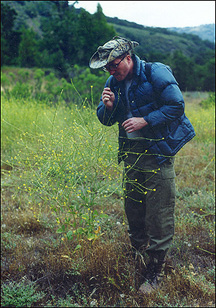
Eating Black Mustard.
|
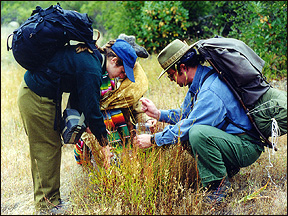
Gathering Sheep Sorrel. |
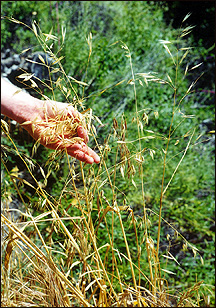
Harvesting Wild Oat seeds.
|
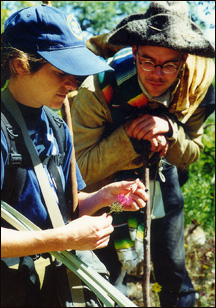
Foraging for Bull Thistle stalks and flowers.
|
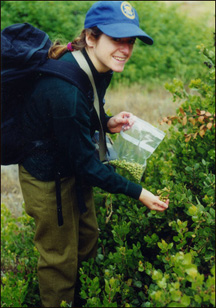
Picking Manzanita berries.
|
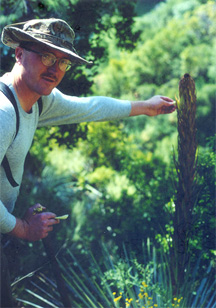
Yucca stalk
|
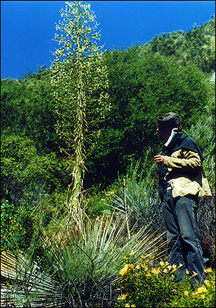
Yucca fruits
|
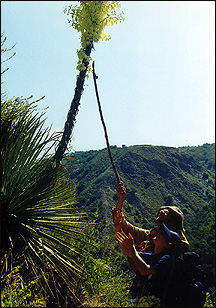
Collecting Yucca blossoms with an improvised picker.
|

Markus tied his knife to a stick to make a picker for gathering Yucca blossoms.
|
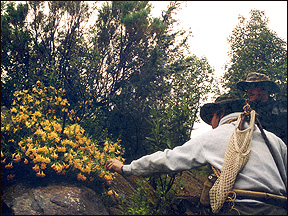
Some of the Sticky Monkey flowers were picked to suck out the sweet nectar from the end of the blossoms. |
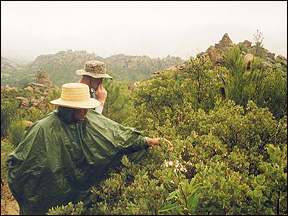
Chewing on Manzanita berries. |
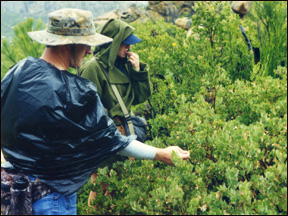
The Manzanita berries were still green and the taste was like eating tart apples. |
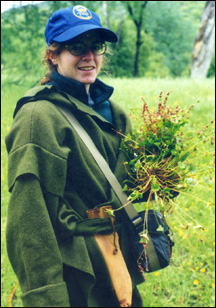
Gathering Miner's Lettuce.
|
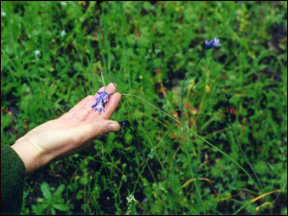
Identifying the blue, purple flowers of Blue Dicks. |
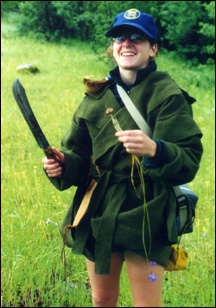
Digging up the edible corm of a Blue Dick. |
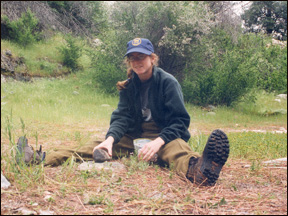
Cracking Gray Pine nuts with a stone. |
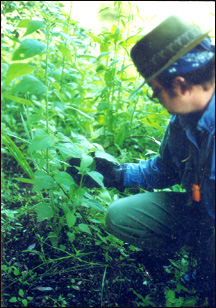
Harvesting the tops of Stinging Nettle leaves with gloves. |

Yarrow was gathered for medicinal uses.
|
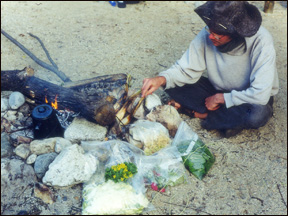
The wild food we gathered. |
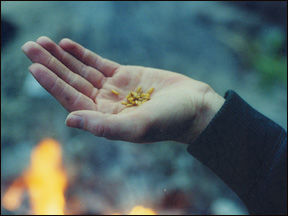
The grains of Wild Oat. |
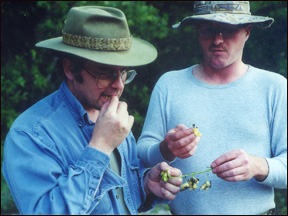
Raw Yucca blossoms have a slightly soapy under flavor. Their flavor is improved by boiling. |
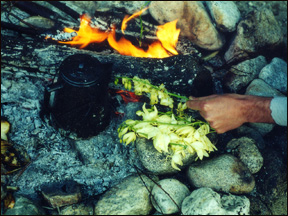
Preparing the Yucca blossoms for boiling. |
Methods used to improve the taste of plant food include soaking, boiling, cooking or leaching.
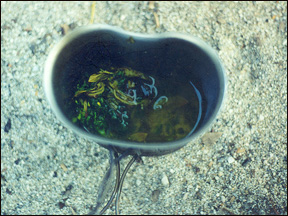
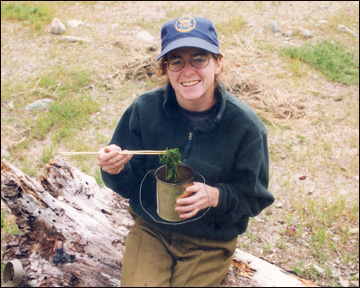
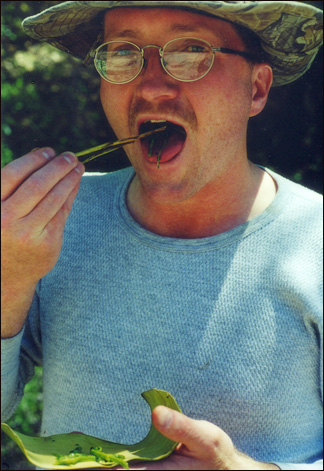
Time to eat!
FOOD
In a survival situation, with the expectation of being rescued, energy expended in the search of food may not be as important as time spent acquiring warmth, providing shelter, finding plenty of drinkable water and seeking rescue (set up signaling). Take care of your most important needs first. Your immediate needs must be prioritized according to your actual situation. Keep in mind that 95% of wilderness survival emergencies are resolved within 72 hours either by outside rescue or self-extraction.
Unless you have extensive knowledge of flora and fauna in the area in which you find yourself, and are very adept at trapping/hunting, finding wild foods will be a challenge in a survival situation. Especially, if you cannot provide at least the required minimum 1500 calories when needed.
If your predicament means that you are only able to acquire very small amounts of food, you might be better off eating nothing at all, unless you are able to provide a bare minimum of 1500 calories daily, provide at least 500 of the above calories in the form of carbohydrates and/or fat and expend at least 1500 fewer calories in obtaining the food than you gain from it. If you plan to stay put until rescue arrives, you will actually survive longer by resting and eating nothing at all, drinking only water. This is because when the amount eaten is less than 1500 calories per day (the basal metabolic rate requirement), the body consumes 6 times more of its protein reserves in relation to fat reserves to make up the extra calories required. If you eat nothing at all, for the first few days, you will experience hunger, lethargy and irritability as your body depletes it's glycogen reserves. Then after the third or fourth day, adaptations take place within the body to decrease the metabolic rate by up to 30%. In starvation mode, this is a more equitable use of the stored proteins and fats in your body so that a healthy adult does not begin to suffer any irreversible deficiences for 40 days. Though, beyond the 40th day there is a rapid decline in health resulting in a very high risk of death occurring at around 50-60 days. After a few days of waiting, you may decide that no one is coming to your rescue. In this case, you must attempt to find your own way to safety. If you expend energy walking out of your present campsite, you will need to find food.
Do you go into starvation mode or look for food near your campsite while waiting for rescue? All situations are different. You will have to assess your predicament and be flexible in making a choice that will be beneficial to your rescue and survival.
It is always wise to give your wilderness agenda and return plans to a reliable person when you go out on extended, or even short trips. No one will come looking for you, if they don't know you are missing when you get lost or injured. Be prepared and use common sense.
Plants
1. Black Mustard - The mustard leaves are eaten raw when they are young and tender. The leaves can be minced and used in soups. Mustard flowers and the unopened buds add a pungent flavor to other raw greens.
2. Wild Oats - The grains of every grass plant can be eaten. The seeds can be roasted and ground into flour. Then, it can be soaked in water and boiled into mush.
3. Sheep Sorrel - Only the leaves are picked. It can be eaten raw or cooked. The leaves have a tart taste due to a high concentration of oxalic acid when eaten raw.
4. Bull Thistle - When thistle is young and the leaves are still in a basal rosette, the roots are edible. The stalk can be lightly cooked or eaten raw. Simply peel the thorns off the young stems and leaves and eat it like celery. Being related to artichokes, some of the thistle flowers have small edible "hearts".
5. Manzanita Berries - The red berries are gathered and ground into a coarse meal. Water is added and allowed to steep to make a cider. The red berries can be picked and chewed to draw out the sweet taste from the rind.
6. Yucca - The flowers and bulbs are edible raw, although light cooking (such as steaming or boiling) improves their flavor. The raw fruits are edible, but the flavor is improved by boiling or sun drying. The young, first-emerging stalk is also palatable cooked.
For more information about Yucca, access http://www.primitiveways.com/yuccas_and_agaves.html on PrimitiveWays.com.
The fibers of the leaves (or the leaves themselves) were made into sandals, mats, whisk brooms, string/rope, baskets and soap.
7. Gray Pine Nuts - The cones are gathered to extract the nuts. The shell is cracked and the seed is eaten.
The pine needles can be steeped in hot water to make a tea. Dried pines needles can be gathered to provide a layer of cushion and insulation between the cold ground and you. Pine resin can be gathered on the bark for making an adhesive or pitch filler material. The resin has anti-bacterial qualities and can be externally applied to small cuts.
8. Blue Dicks - The underground corms are dug up and eaten raw or lightly roasted over coals.
9. Miner's Lettuce - The leaves, stems and flowering stalks are palatable raw. It can also be cooked or steamed.
10. Stinging Nettle - Gather only the tender nettle tops. Be careful of the hair-like needles on the plant that can sting you. The nettles have formic acid. If you have gloves, use them. Or wrap your hand in a T-shirt to pick the leaves. The leaves are cooked to make a delicious and nutritious soup.
The dry stalks contain silky fibers that can be made into cordage. The best fibers are gathered in fall.
11. Yarrow - The leaves and stems can be crushed and used on wounds, cuts, scrapes, rashes and burns. Yarrow can be applied on the spot to help stop bleeding and aid in healing.
Learn to identify and prepare the plants you can use for food, medicine and tools in different regions. Their unique characteristics can supply you with raw materials to construct shelters, build fires and make cordage, as well as provide for other necessary needs.
Edible and useful plants information on PrimitiveWays.com:
a) Useful and edible plants in California (part 1) - http://www.primitiveways.com/plants.html/index.htm
b) Useful and edible plants in California (part 2) - http://www.primitiveways.com/plants2.html/index.htm
c) Useful and edible plants in California (part 3) - http://www.primitiveways.com/plants3.html/index.htm
d) Uses of Soap plant - http://www.primitiveways.com/soap%20plant.html
e) Gathering and harvesting calendar - http://www.primitiveways.com/harvesting_gathering.html
Insects
What people choose to eat is conditioned by culture. Despite a long tradition of insect consumption in other countries, insect eating is still rare in the United States and Europe. In a survival situation, the aversion to eating insects must be overcome mentally. Eating insects can provide an excellent source of nutritional food.
There are 1,462 recorded species of insects that are eaten. Many edible insects are high in protein and fat content than most meat. They are also loaded with vitamins and minerals. Cooked insects can be eaten whole or they can be ground into flour to add to soup, stew or other dishes for an added protein boost. One of the easiest ways to prepare insects is to roast them over coals or hot ashes.
Cicadas, grubs, field crickets, ants, grasshoppers, beetle larvae, termites, worms and aquatic fly larvae are some of the edible insects one is likely to find in the wild. Look under and within rotten wood, beneath rocks and in sheltered spots where insects may be found. Insects are often quite easily acquired in large numbers with minimal effort.
Insects provided another source of food to our wilderness diet.
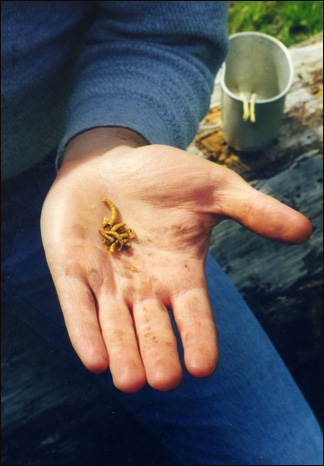
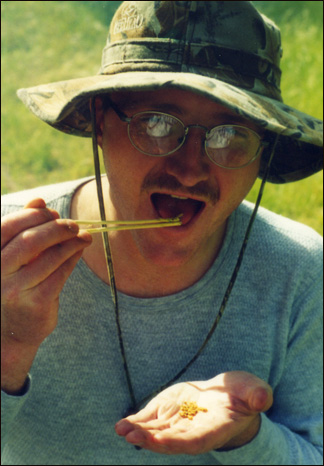
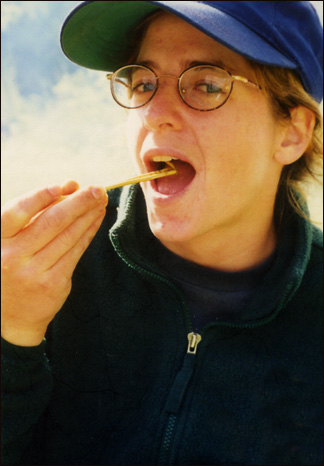
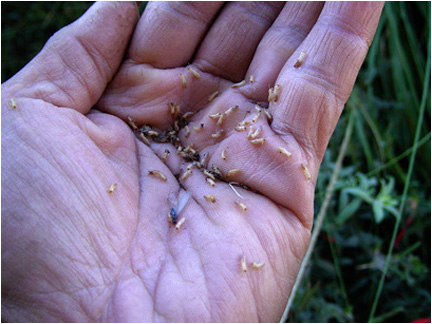
Termite larvae
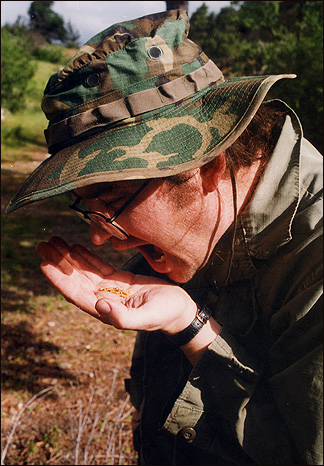

Sometimes the only way to eat the insects was to gulp it down real fast.
Crayfish
Crayfish are freshwater crustaceans resembling small lobsters. They are found in brooks, streams or lakes where there is fresh water running and have shelter against predators. Crayfish are omnivorous, eating just about anything they can find or catch. They feed on living, as well as, dead animals and plants.
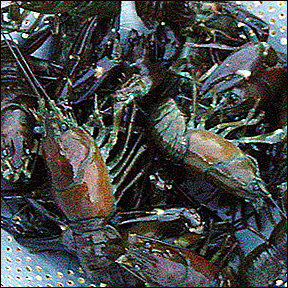
The easiest method to catch crayfish is by hand. All you need is a piece of string long enough to cast out to where the crayfish are hiding or crawling on the bottom of the stream. Cordage can be made from any available plant fiber or strips of cloth from your clothing. Bait is securely attached to the end of the string. An insect or any food that will attract the crayfish can be used as bait. Tie a small stone about 5 inches from the bait to add weight to your cast and to allow the bait to sink to the bottom. Toss your bait and stone beyond the intended crayfish and slowly drag the bait towards the crayfish. When the crayfish grabs the bait, let it feed for a few seconds, then slowly pull the crayfish towards you. Most crayfish will hold on to the bait tenaciously with their claws. As the crayfish gets closer to you, do not pull it out of the water, but keep the crayfish submerged. When it is within grasping range, grab the head area starting from behind the tail or scoop it quickly onto the shore.
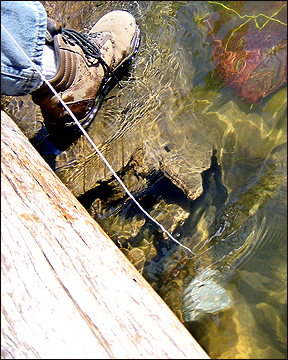
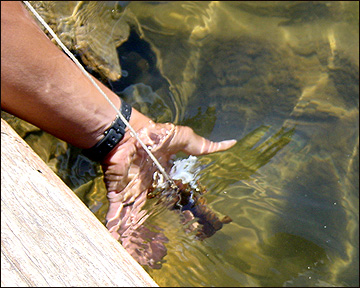
Various traps can be constructed to catch crayfish. Secure the trap with heavy stones. The rocks will keep the trap on the bottom and from drifting away. Also tie the bait deep inside the trap and attach a cordage or stick to the trap for easy retrieval.
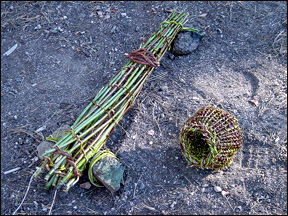
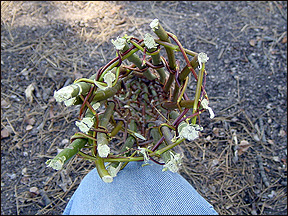
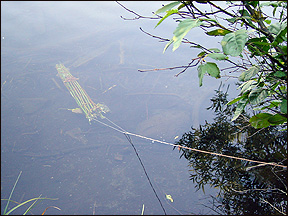
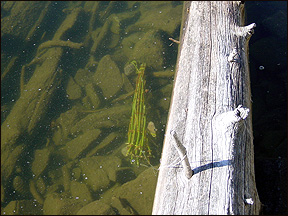
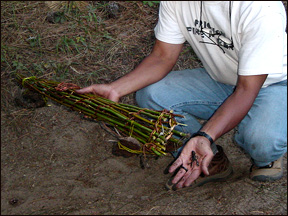
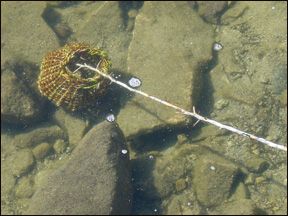
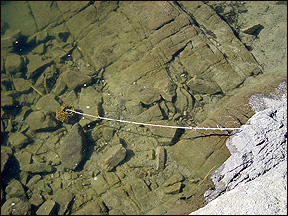
Crayfish traps made from willow.
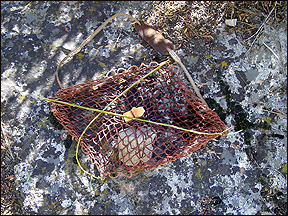
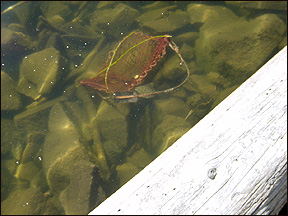
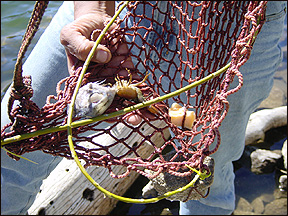
A crayfish trap was improvised from a netted carrying bag. Flexible willow branches were tied with willow bark to the four corners of the netted bag. The willow branches kept the net structure open. Stones were tied to the net to weigh it down and cordage was attached to the bag strap to haul it in.
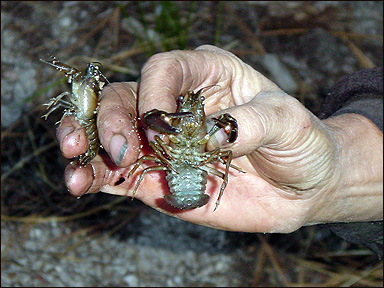
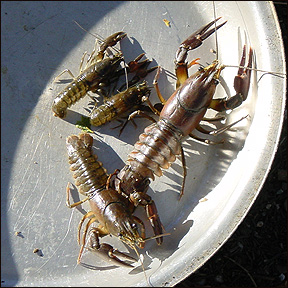
After boiling, the tail portion is usually consumed. However, other portions may be eaten. Claws of larger boiled specimens are pulled apart to access the meat inside. Another source of food is to suck the head of the crayfish, as flavor can collect in the fat of the boiled interior.
Catching crayfish by hand, using cordage and bait, was the most efficient and easiest method. The crayfish was boiled in water until the outer shell turned red in color.
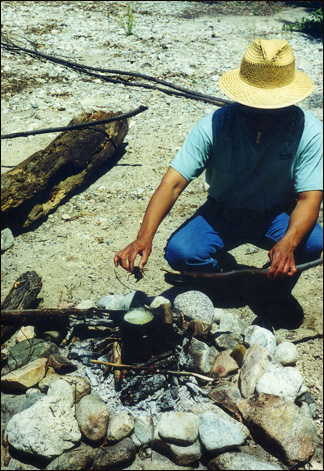

Remember . . . . the ability to find wild foods during a survival situation depends upon previous study and practice. Plants and insects are often the easiest and most abundant foods to acquire. Fish are another source of food, if you can locate water, know something about the behavior of the fish and have the knowledge on how to catch them. Depending upon mammals and birds for food may not always be reliable in an unfamiliar location. Hunting is not always an assured way of obtaining food on a day to day basis even by those with experience. Trapping might be another alternative to acquiring meat, but you will need the knowledge and skill to find animals and know how to construct effective traps or snares.
Continued

E-mail your comments to "Dino Labiste" at KahikoArts@yahoo.com
PrimitiveWays
Home Page
We hope the information on the PrimitiveWays website is both instructional and enjoyable. Understand that no warranty or guarantee is included. We expect adults to act responsibly and children to be supervised by a responsible adult. If you use the information on this site to create your own projects or if you try techniques described on PrimitiveWays, behave in accordance with applicable laws, and think about the sustainability of natural resources. Using tools or techniques described on PrimitiveWays can be dangerous with exposure to heavy, sharp or pointed objects, fire, stone tools and hazards present in outdoor settings. Without proper care and caution, or if done incorrectly, there is a risk of property damage, personal injury or even death. So, be advised: Anyone using any information provided on the PrimitiveWays website assumes responsibility for using proper care and caution to protect property, the life, health and safety of himself or herself and all others. He or she expressly assumes all risk of harm or damage to all persons or property proximately caused by the use of this information.
© PrimitiveWays 2013















































